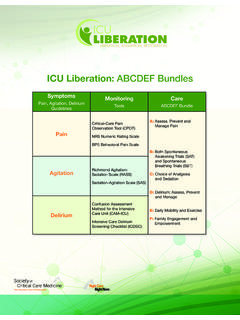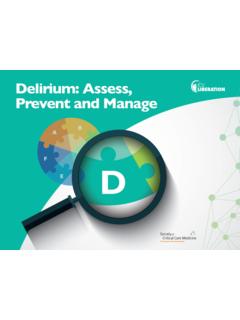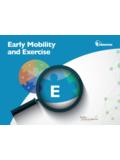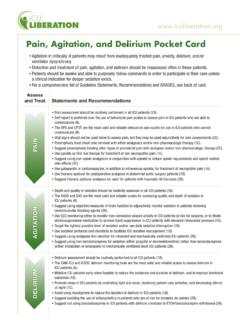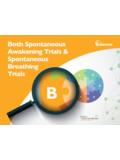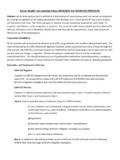Transcription of Patient-Centered Rounds Using the ABCDEF Bundle
1 Patient-Centered Rounds Using the ABCDEF Bundle Facilitator Guide for the Video Vignettes Series Brenda T. Pun, RN, MSN, ACNP. Copyright Society of Critical Care Medicine Reproduction Granted for Hospital Staff Training Only Page 1 of 14. ICU liberation ABCDEF Patient-Centered Rounds Facilitator's Guide TABLE OF CONTENTS. INTRODUCTION .. 3. BACKGROUND .. 4. HOW TO USE THESE VIDEO VIGNETTES .. 6. Practical Preparation for Using These Video Vignettes ..6. Recommended Strategies for General Debriefing and Facilitating Group Discussion ..7. Video 1: Specific Debriefing Instructions .. 8. VIDEO 2: SPECIFIC DEBRIEFING INSTRUCTIONS .. 9. Video 1 Plus Video 2 ..9. VIDEO 3: SPECIFIC DEBRIEFING INSTRUCTIONS .. 10. Video 2 Plus Video 3 .. 10. ACKNOWLEDGEMENTS .. 11. RESOURCES .. 12. REFERENCES .. 13. Copyright Society of Critical Care Medicine Reproduction Granted for Hospital Staff Training Only Page 2 of 14.
2 ICU liberation ABCDEF Patient-Centered Rounds Facilitator's Guide INTRODUCTION. This video series and accompanying educational materials are intended to facilitate discussion within interprofessional teams around communication and collaboration in the intensive care unit (ICU), especially as it pertains to the elements of the ABCCEF Bundle . The ABCDEF Bundle is a set of interconnected and interdependent evidence-based guideline-recommended interventions that includes the following elements1 . 3. : - Assess, Prevent, and Manage Pain - Both Spontaneous Awakening Trials and Spontaneous Breathing Trials - Choice of Analgesia and Sedation - Delirium: Assess, Prevent and Manage - Early Mobility and Exercise - Family Engagement and Empowerment These video series provide examples of patient care Rounds that include the integration of the ABCDEF Bundle elements.
3 While none of these cases are intended to be perfect, some of the interactions are better than others. The videos are intended start conversations that will provide an opportunity for interprofessional teams to discuss how styles of patient care Rounds can facilitate or hinder patient care. Additionally, they can be used to facilitate conversations about the deliberate use of tools, such as the ABCDEF Bundle language, Brain Roadmap script, and goals checklists, as a strategy to organize the discussion of patient care. This Facilitator's Guide contains: An overview of each video Strategies to create an environment in which the learners are allowed to reflect openly and recognize good and poor communication A template for showing the video Suggestions for facilitating debriefing discussions Additional questions to facilitate conversation on specific elements addressed in each video Copyright Society of Critical Care Medicine Reproduction Granted for Hospital Staff Training Only Page 3 of 14.
4 ICU liberation ABCDEF Patient-Centered Rounds Facilitator's Guide BACKGROUND. The ABCDEF Bundle has been recommended as a grouping of evidence-based cohesive steps to implementing the Society of Critical Care Medicine (SCCM) guidelines for Pain, Agitation, and Delirium and Family 3. The Institute for Healthcare Improvement (IHI) defines a Bundle as a small, straightforward set of evidence- based practices that, when performed collectively and reliably, has been proven to improve patient The use of bundles has been shown to improve communication and collaboration in the ICU and has resulted in improved compliance with guideline recommendations. The individual elements of the ABCDEF Bundle have been shown to decrease delirium days, ventilator time, ventilator-associated events, ICU lengths of stay and hospital lengths of stay, and to increase 7. Grouped together, the ABCDE Bundle (F had not yet been added) was synergistically reported to decrease ventilator time, decrease delirium days, and increase However, many institutions report a lag in bedside implementation of these practices.
5 Bundling the guideline recommendations into the ABCDEF Bundle provides a framework for understanding the relationships among them ( , the difficulty of mobilizing a deeply sedated patient). Additionally, bundling emphasizes that, as the interventions are interrelated, the healthcare team members responsible for them are also dependent on one another. Thus, successful implementation of the Bundle requires teamwork and collaboration within the interprofessional team that includes nurses, physicians, pharmacists, respiratory therapists and rehabilitation therapists, as well as the patient, family members and significant others. While ICU clinicians and leaders need to focus on updating existing policies and procedures related to these interventions, it is equally essential for ICU teams to focus on team building and communication. In a study describing Bundle implementation, Balas et al9 reported that the performance of daily interprofessional Rounds was a key factor effecting compliance with the Bundle elements.
6 These video vignettes focus on the use of patient care Rounds to facilitate communication of information and coordination of care. Patient care Rounds are gatherings of multiple healthcare providers to review individual patients and map out plans of care. Most ICUs report that Rounds happen daily with an interprofessional team. Using a standardized format with structured presentations has been shown to increase the effectiveness of communication in patient care The Brain Roadmap script is one tool, directly related to pain, agitation, and sedation protocols that could be used to facilitate structured ,12 The Brain Roadmap is a suggested script developed to guide the bedside nurse during patient care Rounds to concisely report on the patient's status as it relates to sedation and delirium. The script facilitates nursing reports on the following points: Where are we going?
7 ( , What is the sedation target for the patient?). Where is the patient right now? ( , What is the patient's current pain level, sedation level and delirium status?). How did we get here? (What sedative, analgesic and hypnotic medications is the patient taking right now?). Copyright Society of Critical Care Medicine Reproduction Granted for Hospital Staff Training Only Page 4 of 14. ICU liberation ABCDEF Patient-Centered Rounds Facilitator's Guide A script allows the nurse to present the data in a predictable and informative way that guides the healthcare team to key discussion points. Based on the data presented, the team might ask, Are we Using the right target? If we have been carrying out daily sedative interruptions, why is the patient still oversedated? Scripts in patient care Rounds allow for teams to synchronize on goals and provide accountability for the use of the protocols.
8 Daily goals checklists are written forms or boards used during patient care Rounds to summarize discussion regarding plans for specific patients . They have been shown to improve communication. Pronovost et al13. reported that including a daily goals form in patient care Rounds significantly increased the staff's understanding of daily goals and simultaneously decreased patients ' lengths of stay. Daily goals forms and checklists have also been shown to improve communication, synchronize care, improve adherence to guidelines and decrease ,14 16. The use of scripts and goals forms during patient care Rounds could enhance interdisciplinary communication on the topic and facilitate proper usage of the ABCDEF Bundle protocols, thereby improving guideline adherence. However, efforts to increase protocol use cannot focus only on teamwork and communication. Other barriers to the ABCDEF Bundle interventions include reluctance to use the tools due to fears about patient safety and increased ,17 These barriers need to be addressed through education and quality improvement projects.
9 Interprofessional patient care Rounds can also be a fruitful forum for addressing issues related to safety fears and workload, especially when bedside nurses are equipped with tools, such as goals checklists and scripts, that allow them to voice those concerns. Copyright Society of Critical Care Medicine Reproduction Granted for Hospital Staff Training Only Page 5 of 14. ICU liberation ABCDEF Patient-Centered Rounds Facilitator's Guide HOW TO USE THESE VIDEO VIGNETTES. This guide should be used by the facilitator to lead the video discussion. It is important not to label the videos as good or bad but rather to present each one as a conversation starter. Each video contains positive aspects and areas for improvement, some more than others. Create an environment in which the learners are allowed to reflect openly and recognize both good and poor communication.
10 This learning activity includes three videos that provide examples of patient care Rounds . For consistency, each video contains the same staff, patient and family member. Video 1: Physician reporting at the bedside with nurse (run time 1:52 min). Video 2: Interprofessional team rounding at the bedside (run time 2:15 min). Video 3: Later in the day, after the events of Video 2 (run time 2:10 min). It is recommended that all three videos be used and that they be viewed in order. However, if time is limited, it is recommended that at least two videos be used to provide the opportunity to compare them. For example, Videos 1 and 2 could be used together or Videos 2 and 3 could be used together. Practical Preparation for Using These Video Vignettes Before showing the videos, facilitators should: Preview the videos and read this Facilitator's Guide. This will equip you with strategies to facilitate constructive conversation for maximum effectiveness of the videos.
